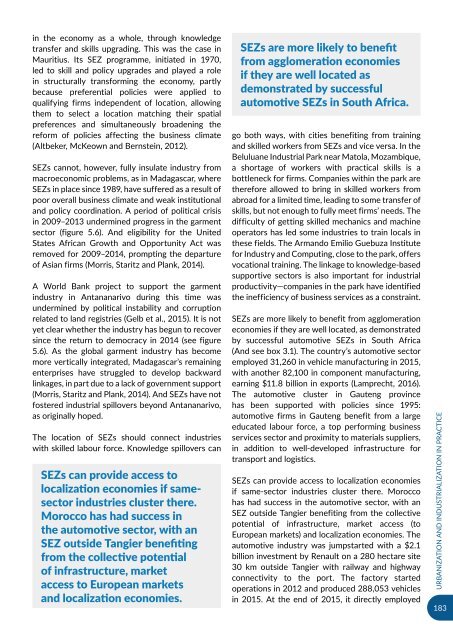URBANIZATION AND INDUSTRIALIZATION
Economic%20Report%20on%20Africa%202017%20UNECA
Economic%20Report%20on%20Africa%202017%20UNECA
You also want an ePaper? Increase the reach of your titles
YUMPU automatically turns print PDFs into web optimized ePapers that Google loves.
in the economy as a whole, through knowledge<br />
transfer and skills upgrading. This was the case in<br />
Mauritius. Its SEZ programme, initiated in 1970,<br />
led to skill and policy upgrades and played a role<br />
in structurally transforming the economy, partly<br />
because preferential policies were applied to<br />
qualifying firms independent of location, allowing<br />
them to select a location matching their spatial<br />
preferences and simultaneously broadening the<br />
reform of policies affecting the business climate<br />
(Altbeker, McKeown and Bernstein, 2012).<br />
SEZs cannot, however, fully insulate industry from<br />
macroeconomic problems, as in Madagascar, where<br />
SEZs in place since 1989, have suffered as a result of<br />
poor overall business climate and weak institutional<br />
and policy coordination. A period of political crisis<br />
in 2009–2013 undermined progress in the garment<br />
sector (figure 5.6). And eligibility for the United<br />
States African Growth and Opportunity Act was<br />
removed for 2009–2014, prompting the departure<br />
of Asian firms (Morris, Staritz and Plank, 2014).<br />
A World Bank project to support the garment<br />
industry in Antananarivo during this time was<br />
undermined by political instability and corruption<br />
related to land registries (Gelb et al., 2015). It is not<br />
yet clear whether the industry has begun to recover<br />
since the return to democracy in 2014 (see figure<br />
5.6). As the global garment industry has become<br />
more vertically integrated, Madagascar’s remaining<br />
enterprises have struggled to develop backward<br />
linkages, in part due to a lack of government support<br />
(Morris, Staritz and Plank, 2014). And SEZs have not<br />
fostered industrial spillovers beyond Antananarivo,<br />
as originally hoped.<br />
The location of SEZs should connect industries<br />
with skilled labour force. Knowledge spillovers can<br />
SEZs can provide access to<br />
localization economies if samesector<br />
industries cluster there.<br />
Morocco has had success in<br />
the automotive sector, with an<br />
SEZ outside Tangier benefiting<br />
from the collective potential<br />
of infrastructure, market<br />
access to European markets<br />
and localization economies.<br />
SEZs are more likely to benefit<br />
from agglomeration economies<br />
if they are well located as<br />
demonstrated by successful<br />
automotive SEZs in South Africa.<br />
go both ways, with cities benefiting from training<br />
and skilled workers from SEZs and vice versa. In the<br />
Beluluane Industrial Park near Matola, Mozambique,<br />
a shortage of workers with practical skills is a<br />
bottleneck for firms. Companies within the park are<br />
therefore allowed to bring in skilled workers from<br />
abroad for a limited time, leading to some transfer of<br />
skills, but not enough to fully meet firms’ needs. The<br />
difficulty of getting skilled mechanics and machine<br />
operators has led some industries to train locals in<br />
these fields. The Armando Emilio Guebuza Institute<br />
for Industry and Computing, close to the park, offers<br />
vocational training. The linkage to knowledge-based<br />
supportive sectors is also important for industrial<br />
productivity—companies in the park have identified<br />
the inefficiency of business services as a constraint.<br />
SEZs are more likely to benefit from agglomeration<br />
economies if they are well located, as demonstrated<br />
by successful automotive SEZs in South Africa<br />
(And see box 3.1). The country’s automotive sector<br />
employed 31,260 in vehicle manufacturing in 2015,<br />
with another 82,100 in component manufacturing,<br />
earning $11.8 billion in exports (Lamprecht, 2016).<br />
The automotive cluster in Gauteng province<br />
has been supported with policies since 1995:<br />
automotive firms in Gauteng benefit from a large<br />
educated labour force, a top performing business<br />
services sector and proximity to materials suppliers,<br />
in addition to well-developed infrastructure for<br />
transport and logistics.<br />
SEZs can provide access to localization economies<br />
if same-sector industries cluster there. Morocco<br />
has had success in the automotive sector, with an<br />
SEZ outside Tangier benefiting from the collective<br />
potential of infrastructure, market access (to<br />
European markets) and localization economies. The<br />
automotive industry was jumpstarted with a $2.1<br />
billion investment by Renault on a 280 hectare site<br />
30 km outside Tangier with railway and highway<br />
connectivity to the port. The factory started<br />
operations in 2012 and produced 288,053 vehicles<br />
in 2015. At the end of 2015, it directly employed<br />
<strong>URBANIZATION</strong> <strong>AND</strong> <strong>INDUSTRIALIZATION</strong> IN PRACTICE<br />
183


